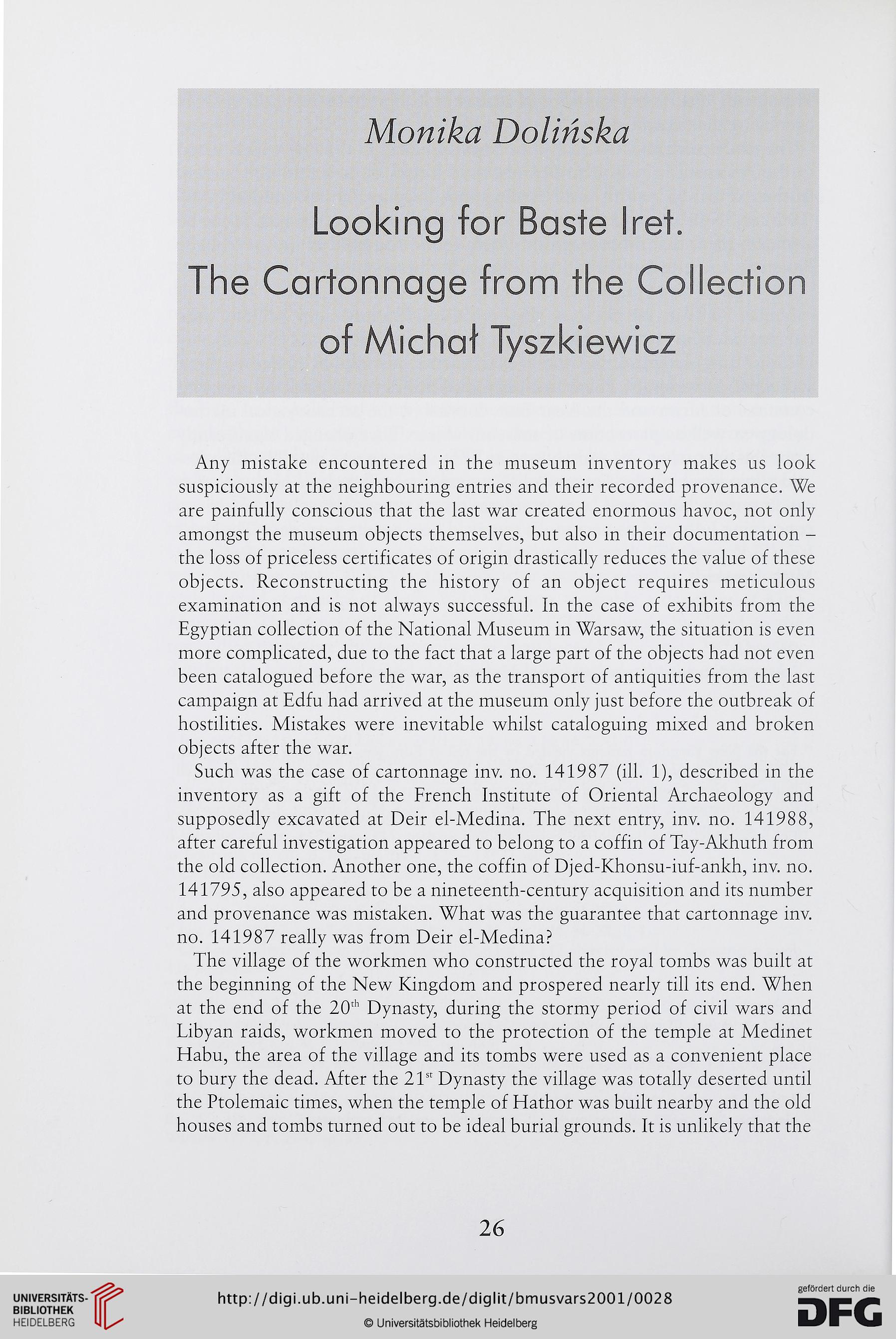Monika Dolińska
Looking for Baste Iret.
The Cartonnage from the Collection
of Michał Tyszkiewicz
Any mistake encountered in the museum inventory makes us look
suspiciously at the neighbouring entries and their recorded provenance. We
are painfully conscious that the last war created enormous havoc, not only
amongst the museum objects themselves, but also in their documentation -
the loss of priceless certificates of origin drastically reduces the value of these
objects. Reconstructing the history of an object reąuires meticulous
examination and is not always successful. In the case of exhibits from the
Egyptian collection of the National Museum in Warsaw, the situation is even
morę complicated, due to the fact that a large part of the objects had not even
been catalogued before the war, as the transport of antiąuities from the last
campaign at Edfu had arrived at the museum only just before the outbreak of
hostilities. Mistakes were inevitable whilst cataloguing mixed and broken
objects after the war.
Such was the case of cartonnage inv. no. 141987 (ill. 1), described in the
inventory as a gift of the French Institute of Oriental Archaeology and
supposedly excavated at Deir el-Medina. The next entry, inv. no. 141988,
after careful investigation appeared to belong to a coffin of Tay-Akhuth from
the old collection. Another one, the coffin of Djed-Khonsu-iuf-ankh, inv. no.
141795, also appeared to be a nineteenth-century acąuisition and its number
and provenance was mistaken. What was the guarantee that cartonnage inv.
no. 141987 really was from Deir el-Medina?
The village of the workmen who constructed the royal tombs was built at
the beginning of the New Kingdom and prospered nearly till its end. When
at the end of the 20th Dynasty, during the stormy period of civil wars and
Libyan raids, workmen moved to the protection of the tempie at Medinet
Habu, the area of the village and its tombs were used as a convenient place
to bury the dead. After the 21st Dynasty the village was totally deserted until
the Ptolemaic times, when the tempie of Hathor was built nearby and the old
houses and tombs turned out to be ideał burial grounds. It is unlikely that the
26
Looking for Baste Iret.
The Cartonnage from the Collection
of Michał Tyszkiewicz
Any mistake encountered in the museum inventory makes us look
suspiciously at the neighbouring entries and their recorded provenance. We
are painfully conscious that the last war created enormous havoc, not only
amongst the museum objects themselves, but also in their documentation -
the loss of priceless certificates of origin drastically reduces the value of these
objects. Reconstructing the history of an object reąuires meticulous
examination and is not always successful. In the case of exhibits from the
Egyptian collection of the National Museum in Warsaw, the situation is even
morę complicated, due to the fact that a large part of the objects had not even
been catalogued before the war, as the transport of antiąuities from the last
campaign at Edfu had arrived at the museum only just before the outbreak of
hostilities. Mistakes were inevitable whilst cataloguing mixed and broken
objects after the war.
Such was the case of cartonnage inv. no. 141987 (ill. 1), described in the
inventory as a gift of the French Institute of Oriental Archaeology and
supposedly excavated at Deir el-Medina. The next entry, inv. no. 141988,
after careful investigation appeared to belong to a coffin of Tay-Akhuth from
the old collection. Another one, the coffin of Djed-Khonsu-iuf-ankh, inv. no.
141795, also appeared to be a nineteenth-century acąuisition and its number
and provenance was mistaken. What was the guarantee that cartonnage inv.
no. 141987 really was from Deir el-Medina?
The village of the workmen who constructed the royal tombs was built at
the beginning of the New Kingdom and prospered nearly till its end. When
at the end of the 20th Dynasty, during the stormy period of civil wars and
Libyan raids, workmen moved to the protection of the tempie at Medinet
Habu, the area of the village and its tombs were used as a convenient place
to bury the dead. After the 21st Dynasty the village was totally deserted until
the Ptolemaic times, when the tempie of Hathor was built nearby and the old
houses and tombs turned out to be ideał burial grounds. It is unlikely that the
26




